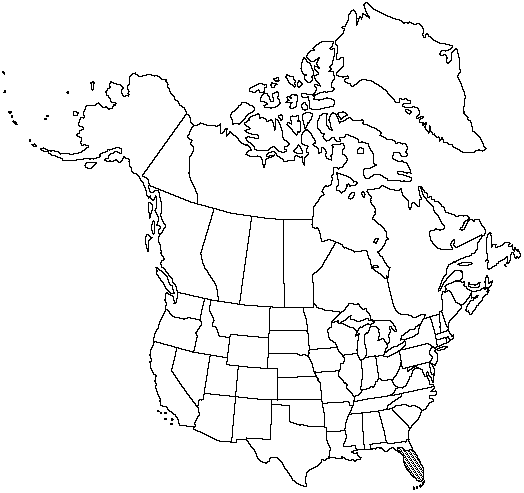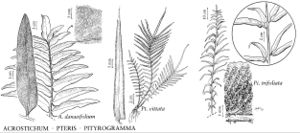Acrostichum danaeifolium
Pl. Voy. Russes Monde 1: 5, plate 1. 1810.
Stems usually erect, infrequently branched. Leaves ascending or erect, 1.5–5 m × 15–60 cm. Rachis shallowly grooved abaxially, flat or shallowly grooved adaxially. Pinnae 20–32 (–64), distant to closely spaced, usually overlapping, 7–37 × 1.5–5.5 cm, tapering toward apex, abruptly acute at tip; costal areoles less than 3 times longer than wide; most pinnae of fertile leaves bearing sporangia. Sporangia spread over abaxial surface of fertile pinnae; paraphyses stalked, ending with horizontally extended, smooth or little-lobed cell. Spores (44–) 54 (–72) µm diam., surface minutely roughened with small projecting papillae. 2n = 60.
Habitat: Somewhat saline to freshwater swamps, canal and pond margins, commonly in sinkholes in hammocks, disturbed marl sites, inland to coastal regions
Elevation: 0–50 m
Distribution

Fla., Central America, South America
Discussion
These species frequently can be distinguished by the distribution of pinnae, the distribution of fertile pinnae, the shape of the costal areoles, and the structure of the paraphyses. In parts of Florida, their distributions are contiguous and abruptly separated by habitat. Acrosticum aureum is more frequently found in coastal shaded areas, in saline black-mangrove communities, and in the southern and southwestern parts of the state. Acrostichum danaeifolium grows vigorously in full sun and is common and widely distributed in Florida, where it has been collected in virtually every county throughout the southern two-thirds of the state. Hybrids have been produced in the laboratory, although these have not been analyzed cytologically. Hybrids are apparently rare in the field and have been reported only in the Dominican Republic (I. García de López 1978).
Selected References
None.
